Happy almost holidays, Tor.com! Please join me for the last Movie Rewatch of Great Nostalgia of the year, won’t you?
Today’s entry is by popular request: 1982’s animated classic The Secret of NIMH! Yay!
Previous entries can be found here. Please note that as with all films covered on the Nostalgia Rewatch, this post will be rife with spoilers for the film.
And now, the post!
MOM: Which one are you doing next again?
ME: The Secret of NIMH. The animated one? With the rats, and the crow, and—
MOM: Oh, that one. I hated that one.
KATE: What? Why?
MOM: I was horrified y’all were watching it. I don’t care if it was a cartoon, that was not a kids’ movie.
And on watching the movie again, my sisters and I… really had to rather agree with her.

I don’t know how long it’s been since you watched The Secret of NIMH, O My Peeps, but I’m here to tell you: this movie is hella dark. Especially for an animated movie supposedly meant for family consumption. Which shouldn’t have been a shock to us, but nevertheless kind of was. Possibly because none of us had seen it in at least a decade (Kate thinks it was more like two decades for her), and yeah, there were clearly some details we had forgotten in the interim.
LIZ: I remember that it scared me as a kid – especially the owl! – but I thought that was just me being a kid. Now, well, I dunno.
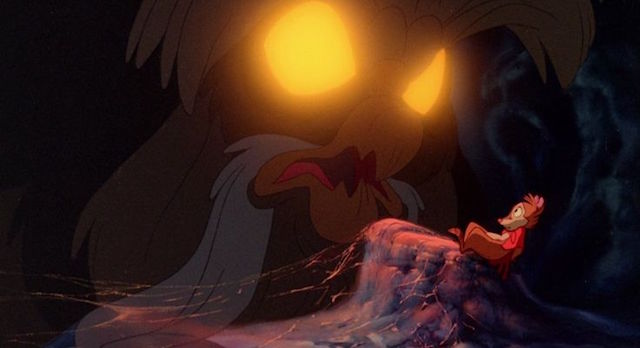
The owl scene was gnarly, y’all. The cobwebs, and the SPIDER (eek), and the owl’s limp, and Don Bluth’s weird thing about showing old age by giving characters boils all over their skin—
KATE: Zits.
Wow, even worse. And that’s not even to mention the straight up double assassination scene at the end, which even shows blood – traditionally a big no-no in any violence under an R rating, animated or otherwise.
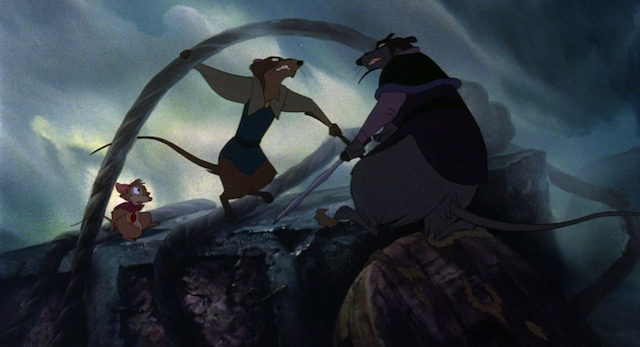
LIZ: No, the worst was the scene at NIMH showing the rats getting injected and tortured, and all the sad caged monkeys and rabbits and, ugh.
ME: So y’all didn’t like it?
KATE: What? No, of course we did.
LIZ: This movie is gorgeous. Dark, but gorgeous.
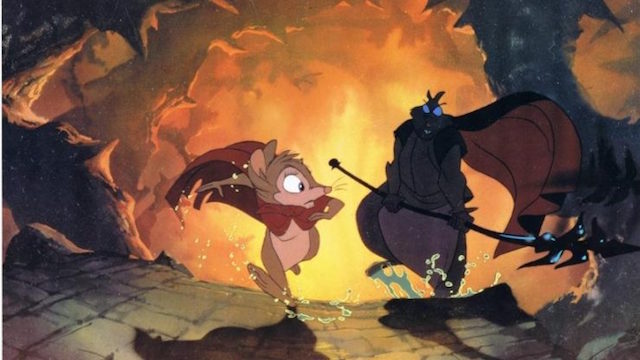
She’s not wrong. Age-zits notwithstanding, the animation on NIMH (Don Bluth’s first feature-length film, by the way) went all out in the “visually arresting” arena, combining the shadowy gloomy backgrounds with amazing blends and pops of color, along with enough sparkly bits to make Jeremy the crow swoon.
Liz pointed out the subdued but beautiful rainbow palette of practically every scene, and commiserated over how long it must have taken to get some of the reflective/shiny/transparent effects properly done. This is old school animation, you guys; everything done by hand, in painstaking layers over layers and multiple camera passes and manual rotoscoping and the whole enchilada to achieve the look they wanted. I love me some computer animation, don’t get me wrong, and really by all accounts it’s just as difficult to make as traditional animation, but there’s something about doing a thing by hand, and how obvious what a meticulous labor of love it is to create something like this film, that resonates.
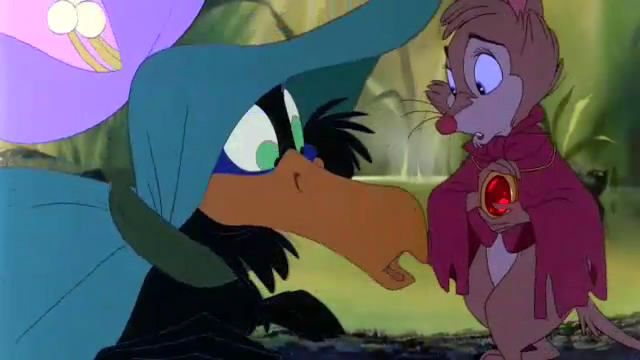
Even if, admittedly, some of Bluth’s choices made more sense aesthetically than they did, er, sensically. Much later (but still a long time ago), I read the 1971 novel by Richard C. O’Brien that the film was based on, and while I don’t remember too much about it, I do remember being quite surprised to discover that the mystical/magical elements in the film were not present in the source material at all; Bluth had added the amulet and Nicodemus being a magician and the big cinderblock-levitating scene at the end and so forth his damn self. He apparently said at the time that it was to add a “spiritual” element to the movie, but really I think it was just an excuse to have as many sparkly glowy firey badass-looking effects in the movie as possible.
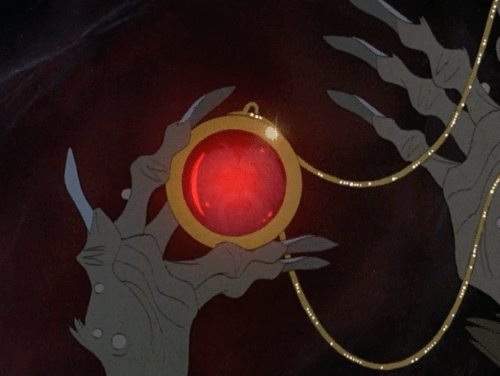
LIZ: …I’m okay with that, really.
Heh. Yes, the magic bits were very pretty, no doubt, but they really made no sense in the context of the story. I mean, supposing that experimental drugs/chemicals from a US government agency end up conveying mystical/supernatural powers to its victims is… well, okay, fine, this is hardly the first time anyone’s ran with that general storyline, but still, it seems pretty random in NIMH.
(Interestingly, in my research for this post I was unable to find any kind of reaction or response, then or later, from the real actual National Institute of Mental Health on the film’s unsubtle depiction of it as a heartless animal abusing charnel house. Though if you would like to be horrified, you can read about this possibly apocryphal claim about the inspiration for the story.)
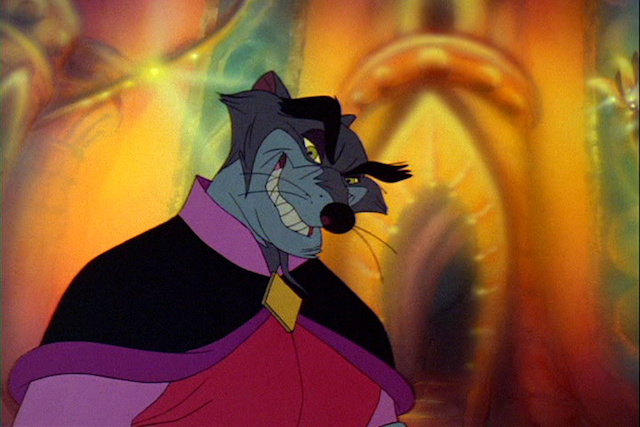
KATE: I also don’t understand why the rats all dress like they’re in a production of King Lear.
I don’t either, really, but I have a half-assed theory about it alluding to their comparative civilization level versus humans. (Also that while it may be weird that the rats have little swords, it would be much, much weirder if they had tiny guns.)
I vaguely recall something from the novel making a big deal about their choice to wear clothes being a sign of the rats’ intelligence, but if so the film rather thoroughly torpedoes that by having non-experimented-on animals wear clothing too. Mrs. Brisby and her kids might be excused by way of having her late husband Jonathan as an influence, true, but that doesn’t explain Auntie Shrew’s matronly garb. And really, are either she or Mrs. Brisby actually less intelligent than the rats or Mr. Ages are? It doesn’t seem like it to me – not on a species-differentiating level, anyway.
KATE: Auntie Shrew gets shit done, that’s for sure.
That she does. Another thing NIMH does really well, by accident or design, is how well it conveys the sometimes unbelievable bravery required of a woman, and especially a mother, who is obliged to fend for herself in a mostly uncaring and often contemptuous world. True, most mothers aren’t specifically dealing with gigantic tractors coming to mow down their houses or having to beard a more-or-less-literal lion in his den (for what is a cat to a mouse but a lion, I ask you?), but these days, Mrs. Brisby’s desperation for anyone to help her with a dangerously sick child and an untenable living situation, neither of which being something anyone else (aside from Auntie Shrew) seems to care about too much, struck a lot closer to home than perhaps was originally intended.
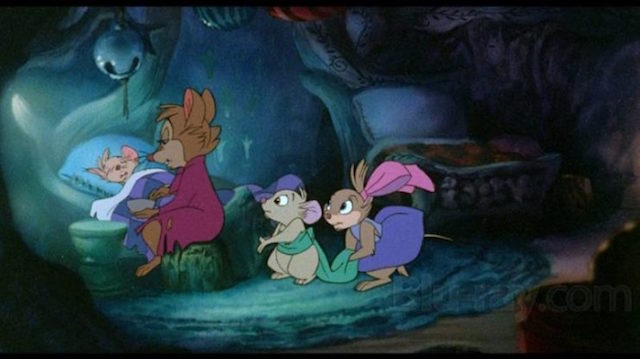
LIZ: They could have at least given her an actual frickin’ name, though.
Truth. Fans of the movie have unofficially named her “Elizabeth”, in honor of her voice actress Elizabeth Hartman, but that doesn’t mollify me much. I tried really hard not to be annoyed that with one exception, none of the other (male) characters seemed to attribute any value to her at all except as an adjunct to her late husband, to the extent of making that her entire identity, but I can reliably report that I did not succeed.
KATE: Well, except the crow. He liked her for her!
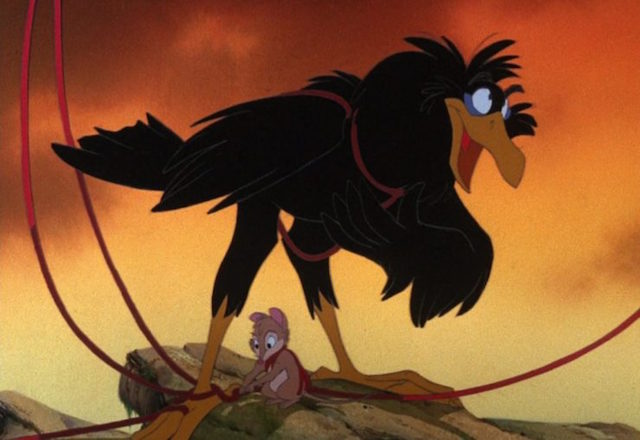
Yeah, Jeremy the crow was just clueless about her plight instead of callous. Granted, when I’m in a bad mood I don’t tend to think that’s much better, but hey.
LIZ: Aw, I loved the crow!
I think Liz mostly just loves the delightfully goofy way Jeremy was animated, in that signature and unmistakable Don Bluth style, but she is also right that he provided a badly-needed bright spot in an otherwise fairly grim and gritty tale. So I don’t actually hate him; I just kind of wanted to punch him in the head at a couple of junctures where he was making Mrs. Brisby’s life more complicated, when that was the last goddamn thing she needed at that point, sheesh.
Jeremy, of course, was voiced by very popular-at-the-time comedian Dom Deluise, who has previously appeared in the MRGN (albeit almost unrecognizably) as PIZZA THE HUT! in Spaceballs. He joined a not-stellar but still mildly impressive cast (in an old school way). Most notable, perhaps, is legendary character actor John Carradine as the stentorian Great Owl, but you also had Derek Jacobi as Nicodemus and Arthur Malet as Mr. Ages, which is hilarious because Malet pretty much had the market cornered on portraying excessively grumpy old codgers long before he actually was one.
Also hilarious: both Shannen Doherty and Wil Wheaton were in this cast too, as Teresa and Martin Brisby, respectively. This is part of a slowly evolving theory I’m working on about Wil Wheaton being, secretly or not, part of every last goddamn kids movie produced in the 80s. HE’S EVERYWHERE AAAAAAAHHH!

I confess, I had a HUGE crush on Justin back in the day. I didn’t realize until this viewing that the reason might have been less that he was the prototypical hero figure, and more that he was the only male character in the entire film who treated Mrs. Brisby with courtesy and respect, even before he found out who her late husband was, and who never once doubted either her word or her courage. All these other losers, including Nicodemus with his needless Dumbledore-y crypticness and Mr. Ages with his dismissive you’re-just-an-hysterical-mother bullshit, can fuck right off as far as I’m concerned. More Justins in this world, I cry!
Aside from that, I was fascinated by him, and really all of the rats in the rose tree, perhaps precisely because we get so very little information on them and their deal in the movie. All the business with Jenner and Sullivan and the politics and the coup attempt gives you very much of a “walked in on the third act of a Shakespeare play” vibe, and while it works on that level, I sort of wish that the film had been able to expand on that whole situation a little more.
But then again, maybe it works better that the rats’ drama is really just a sideshow to the central story. Which is Mrs. Brisby’s, and really quite the traditional Hero’s Journey, at that: her literal quest to save her son, which she accomplishes by venturing out from her small world, seeking out knowledge, braving untold dangers, making allies where she had none, slaying drugging the Dragon, and finding in the end that she had the power to save her family within herself the whole time.
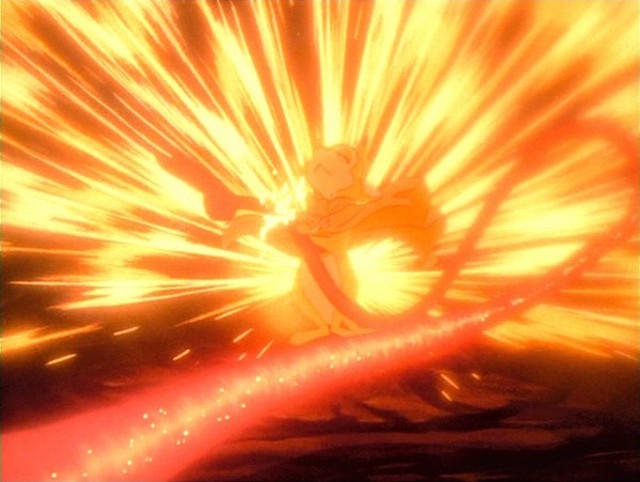
Our mother was right; The Secret of NIMH wasn’t – and isn’t – really a movie for kids at all. But that might be why we appreciated it more as adults. It was a sad and dark and beautiful and weird and creepy and fascinating and strangely meditative film that probably had no business ever getting off the ground, much less going on to become a classic, but gosh, I’m glad it did.
And as nearly always, we close with our Nostalgia Love to Reality Love 1-10 Scale of Awesomeness!
Nostalgia: 6
Reality: 8 (Liz: “one whole point added just for the animation!”)
And that’s the MRGN for 2017, kids! I wish you all a wonderful end-of-year celebrational thingy, in whatever configuration that works for you, and I’ll see you with fresh pickin’s in 2018! Cheers!










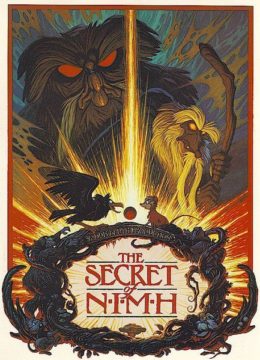
I loved this movie as a kid. I showed it to my daughters a few years ago and they freaked out and cried, and I had to turn it off. They watch all KINDS of things without this happening, so I didn’t really get it at first. After some thought, though, its obvious. This stuff is scary because we care so much for the characters.
They’ve seen every single Marvel movie now, but the only time they cried and wanted me to turn it off was when Tony Stark and Steve Rodgers started beating the s**t out of each other at the end of Civil War. Because they cared for the characters so much.
Crank that nostalgia meter up to a 10 for me on this one. It’s one of my quintessential nostalgic memories of my childhood. I haven’t seen it since my childhood, though.
I’ve only ever seen this one as an adult, but I read my copy of the original book until it fell apart. I even have fond memories of the sequels, though the second one was a bit meh.
I must confess, I don’t like the plot changes – much of what I loved about the book was that all the rats were clever and had learned SCIENCE!, so they use a carefully arranged crane and engineering to smoothly move everything into a place that will always be safe from the Plow. I also didn’t like the character arc of Jenner – he was much better as an offscreen villain and we lost the whole “evil scientists from NIMH are here!” plot.
But goddamn it’s a pretty film.
The worst part for me was always the cage scene.
I remember taking my son to see this. But if it came out in 1982, that means he was four when he saw it. I’m surprised I didn’t scar him for life, as it is a very dark tale. The thing we remembered the most, though, was the crow. In our family, “Look, a sparkly,” was one of those lines that we repeated on a regular basis. It was a very well crafted movie, and beautiful visually. That was the period where we wondered if Disney had lost their mojo, and if Bluth and company might end up being the driving force in animated features.
My boyfriend loves this movie to death and always has. A big part of it is the glorious animation, the music, and of course the magic/mysticism because he’s a sucker for that, and he also adores Mrs. Brisby to pieces. I’m sure there are more reasons than that, but he’d have to tell you what they are.
Me? I loved it just as much as a kid, and yes I absolutely remember how chilling and dark it was. But that was indeed precisely why I liked it. I liked that it didn’t talk down to me, that it believed I could handle the fact the world could be and often was dark and cruel, but that it also gave me hope through things like courage, sacrifice, and heroism. And it also dared to tell me that things like the government, science, and authority in general could be not only wrong, but outright working against the common good. Not that I think it was trying to tell us to outright hate and reject them, but that we should always be suspicious and wary of those in power to make sure they can be held accountable. Which, like the main plot of a single mother fighting to protect her home and her sick child from an uncaring world, is another point which resonates even more now in 2017 than it did at the time…
On a side note, while we can opine that at the time this came out, people (and agencies) were far less sensitive to criticism and could handle it without resorting to suppression or the undercutting of truth and legitimacy, or that like so many others they dismissed the movie as having no real value because it was animated/for kids, I’d like to think the reason NIMH didn’t complain or respond at all is because they actually understood and appreciated the critique, that we have to be careful not to cross into cruelty or immorality even–or especially–in the name of science and progress.
I read O’Brien’s book years later, and while I remember being disappointed at first in the lack of magic and mysticism, I also remember enjoying it in its own right, and thought it too had a lot of things to say about what civilization and intelligence actually mean, how they develop, what are right and wrong and what can be justified in the name of survival, the differing points of views between species/cultures, and more. (I also remember really loving the interlude at the old mansion with Nicodemus and its library but then I am a sucker for libraries, books, and learning.) When I came back to the movie years later, I admit to being a bit jaded about the magic, and thinking it made no sense–this was before I’d been reminded of the in-story handwave, that the experimentation and drugs unlocked special abilities in the rats; I did in fact instantly flash to Firestarter, and in retrospect NIMH does have some very Kingsian elements, doesn’t it? Anyway, of course this still doesn’t explain where the amulet came from, but then we don’t know how the rats got their clothes and swords either. So I set my disbelief aside and came to embrace it once again.
All that said, I never stopped loving the movie, and appreciating both it and the book for their differences as well as what they had in common. (I have to admit rather loving the sequel, Racso, that was written by O’Brien’s daughter, even if I was a bit thrown by Jenner’s arc.) Beautiful, glorious animation, wonderful music (“Flying Dreams” still makes me cry today), awesome characters. Jeremy is hilarious, and yes I too had (and still have) a major crush on Justin; he was in fact my first gay crush, before I even realized who I was or what that meant.
Also have to comment that I really loved the sound work on this film, and one of the more interesting bits was contrasting the monstrous, almost genuinely dragon-like sounds Dragon made from Brisby’s POV, vs. how normal and cat-like he sounded from Mrs. Fitzgibbon’s POV. Not that he still wasn’t creepy even then, but he seemed a lot more like an old and gnarled kitty than an outright spawn of Satan, so as a cat-lover I appreciated that.
So yeah, HUGE love for this movie, both in nostalgia and reality!
P.S. I have to add that the fact Wil Wheaton voiced Martin is humorous for another reason–that in the sequel movie (which we otherwise never talk about), Martin becoming the villain then rather seems like a fun commentary on how many people ended up hating Wesley Crusher and thinking he was a villain, hah!
I first saw this movie at the perfect time in life. That age where you’re sick and tired of typical “kids” stuff but real adult fair is either unobtainable or incomprehensible. This was right in that middle zone and I adored it. But the coolest thing about this movie to me is that it still holds up today. So many of the other things I loved from that time are nearly unwatchable as an adult today but this one? This one is still an all time masterpiece in my book.
I also loved this as a kid. I never read the book, sadly. For some reason I only had a weird sequel (kids find the rats in a valley or something… ??) and a graphic novelization of the movie! I read the comic to pieces.
I finally watched the movie again a couple years ago and omg GRIM!! The bad rat actually succeeds at the assassination?! But I was just as moved by Mrs. Brisby trying to save her kids as I ever was, if not more so.
@8
That’s the second sequel – R-T, Margaret, and the Rats of NIMH.
The first book ends with the rats leaving the farm to travel to a new site they’ve scoped out away from people where they can develop in peace. The second book has the formerly sick mouse boy Timothy travel to the new site, along with the son of Jenner, where they are educated alongside the rats. They then have to prevent humans from flooding the area with a dam. The third has some kids get lost and be found by the rats, they keep them alive over the summer but have to send them back to the world as winter comes. In the spring when people come looking the rats have moved on again to somewhere unknown. .
Both sequels were written by O’Brien’s daughter Jane Leslie Conly.
I do remember it being dark (even before I understood what ‘dark’ meant), but just the screen shots you’ve captured alone demonstrate how beautiful it is. I begged and pleaded and “won” a copy of the storybook from my parents after seeing the movie, just so I could admire the photos. I’ve a young daughter now who indulges in scary stuff, I should definitely try this on her. Not sure her even younger brother will withstand it, though.
I love the book passionately, and when the movie came out, was excited for about 5 seconds before I found out that it had completely violated the premise of the book. I never watched the movie and still have no plans to do so.
Still love the book. SCIENCE.
My brother and I still quote this movie at each other all the time….
Take what you can when you can…..
Then you have learned NOTHING!
There used to be a children’s programme on the BBC called Jackanory, where an actor read a children’s book over 5 afternoons, with still pictures at intervals. The actor they got for Rats of NIMH was Anthony Quayle!
I saw this movie around 11ish. I thought it was great and still do but man is it dark. The owl is just terrifying. I read at least the first two books but not the third for some reason. I enjoyed both stories with and without magic. I’m more partial to magic in my stories. Justin is the best . I didn’t Mrs. Brisby was less intelligent than the rats she might have been more so because her husband taught her and the children to read and she was unmodified by NIMH. It’s definitely an 8.
Suggestions for next year’s Movies
Lady Hawk, Beast Master, Farris Bueller’s Day off, Breakfast Club, the Princess Bride, Gremlins, Krull, Labyrinth, Never Ending Story, Splash, Ghost Busters.